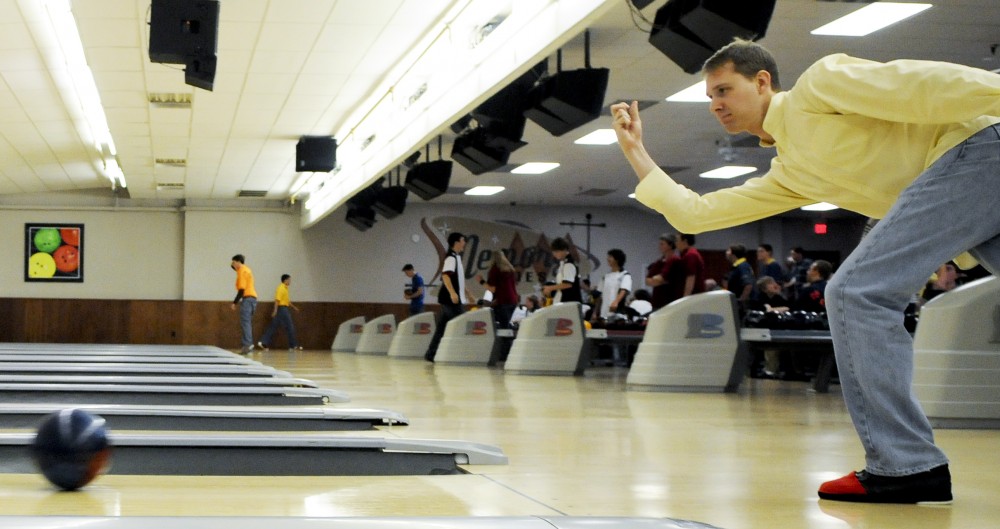As the UniversityâÄôs new bowling group competed in their first collegiate tournament this weekend, they had another rule to follow beyond tournament regulations âÄî they couldnâÄôt use the UniversityâÄôs name to identify themselves. Gopher Bowling , a registered student group, is beginning its first season without rights to the UniversityâÄôs full name because they are not an official club sport, president and founder of the group Danny Rado said. Rado, a non-degree seeking graduate student, said to be considered for official club sport status teams often have to spend a year as a student organization to prove stability of membership. âÄúSince this is our first year,âÄù he said, âÄúitâÄôs either make it or break it.âÄù The co-ed team, which has 10 members, practices twice a week at Memory Lanes in Minneapolis at no cost through an agreement with the alley, Rado said. Reducing costs is something important to the team, as it doesnâÄôt receive any financial support from the University, Rado said. Team members must pay a $250 membership fee to participate in the group. Vice president of Gopher Bowling, senior Thomas Schneider , said the fee covers a team uniform, transportation to tournaments, tournament costs and participation in practices. âÄúThatâÄôs why weâÄôre hoping to get the [club] status next year because hopefully that will cut our costs,âÄù he said. This weekendâÄôs tournament, the 38th Annual Hammer Midwest Collegiate Tournament, held in Menomonee Falls, Wis., hosted 38 schools bringing 72 teams, and had an entry fee of $275, Schneider said. Other Big 10 schools including Purdue, Illinois and Wisconsin participated in the tournament, Schneider said. The annual tournament is sanctioned by the U.S. Bowling Congress Collegiate program , which oversees college tournaments. According to the USBC website, more than 170 colleges and universities offer intercollegiate bowling programs. Teams can have up to eight members on a roster for substitutions, but only five members compete at a time, Schneider said. Heading into the tournament, Schneider said the team practiced as much as possible and hoped to use the tournament to meet other teams and coaches, as well as to gain competitive experience. âÄúBeing that we are a new team and most of the teams are established already, anything is possible,âÄù he said. âÄúItâÄôs one of those sports where anyone can walk in and win.âÄù The top 15 teams will win anywhere from $350 to $2,000 in prize money, Schneider said. The tournament wrapped up after press time on Sunday. Rado said any money won will go directly back to the development of the group. âÄòThe reputation of a geek sportâÄô Nutrition junior Jessie Fitzsimmons said she joined the team because she had bowled in a league when she was younger, but hadnâÄôt much since she went to college. âÄúIt kind of gets the reputation of a geek sport,âÄù she said. âÄúIâÄôve always really enjoyed it and once you get to know the people on the teams, they really are just normal people.âÄù Although it is an individual sport, playing on a team has its advantages, Rado said. Nursing senior Judith Chan said before joining the team she never had anyone coach her. âÄúThe knowledge and skills of the other people on the team has really helped me,âÄù she said. Chan said she used a new 13-pound ball for the first time Friday, which allows her to use a different method of throwing. âÄúYou want the heaviest ball you can hold because when it hits the pins it makes a bigger impact,âÄù she said. By having a bowling team at the University, Chan said students can take the opportunity to learn a lifetime sport that doesnâÄôt have a prime playing age. Computer science junior Collin Layton said itâÄôs important not to forget that bowling is a great social activity, along with being competitive. âÄúItâÄôs not terribly active,âÄù he said. âÄúBut, itâÄôs a sport and it should be recognized as one.âÄù

Image by Stephen Maturen
Gopher Bowling Team founder Danny Rado practices with the team on Friday at Memory Lanes bowling alley in Minneapolis. Rado, a graduate student at the U, bowled for his universities team while pursuing his undergraduate degree in Arizona and decided to found the team at the U.
Gopher Bowling aims to be official club sport
Published October 5, 2008
0

